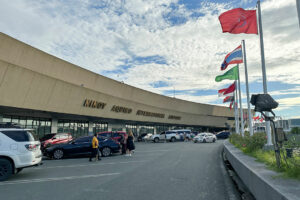




Quarterly Economic Growth Release: More BSP cuts to come
 DOWNLOAD
DOWNLOAD

Monthly Economic Update: Fed catches up
 DOWNLOAD
DOWNLOAD

Inflation Update: Steady and mellow
 DOWNLOAD
DOWNLOAD


DoTr defends planned hike in NAIA charges

The planned hike in passenger service fees at the soon-to-be privatized Ninoy Aquino International Airport (NAIA) would help improve its operational efficiency, the Transportation department said, but analysts said the move is ill-timed and unjustified.
“Certain revenues at the airport will be shared with the government, the Passenger Service Charge (PSC) is excluded from the revenue share. The PSC is one of the largest components of overall airport revenue streams,” Transportation Undersecretary for Aviation and Airports Roberto C.O. Lim said in a Viber message.
The Department of Transportation (DoTr) said the Manila International Airport Authority’s (MIAA) plan to hike fees and charges at the NAIA is based on inflation and the required capital expenditure for the airport’s rehabilitation and capacity expansion.
“The airport needs very significant capital investment to bring it up to an acceptable service standard for passengers, to improve safety and to increase the number of landing and takeoff slots available for airlines,” Mr. Lim said, adding that fees and charges at the airport have not increased for the past 24 years.
The DoTr added that the planned rate increase was also included in the approved parameters, terms and conditions under the tender documents for the NAIA rehabilitation project.
The New NAIA Infrastructure Corp. (formerly SMC SAP & Co. Consortium) in March signed the P170.6-billion contract to operate, maintain and upgrade the country’s main gateway for 25 years. It is set to take over the operations of the NAIA by September.
The government expects to earn P900 billion from the project, or P36 billion a year. This is 20 times bigger than the P1.17 billion remitted by the MIAA annually in the 13 years through 2023, according to the Transportation department.
The passenger service charge is P200 for domestic travelers, while foreign travelers pay P550.
The DoTr declined to reveal exactly how much the passenger service fees will increase, although it is expected to be implemented once the new concessionaire takes over.
However, CitizenWatch Philippines in a statement said the passenger service charge would increase to P390 for domestic travelers and to P950 for international travelers.
“We urge the government and the winning airport consortium to stop this looming hike. It is a brazen, unconscionable imposition on long-suffering passengers who have had to endure inadequate facilities and substandard service in our airports,” CitizenWatch Philippines Co-Convenor Jose Christopher Y. Belmonte said.
Rene S. Santiago, former president of the Transportation Science Society of the Philippines said proposed hike in fees is unjustified.
“Bad justification. SMC will put in the investments required, not the government. The rate increase is justified after the service upgrade, not before,” he said in a Viber message.
The DoTr said it had been in communications with airline associations that agreed the proposed fees and charges are justified and are long-overdue to “rehabilitate NAIA and elevate it from its current dismal condition.”
It also said the government is working to make assets and land available as the new NAIA concessionaire has committed to deliver significant capital investments for the airport.
The New NAIA Infrastructure is planning to build a new passenger terminal building with a total capacity of 35 million passengers per year as part of its commitment to decongest the airport.
“It is a given that airport enhancements require funding. It is not a given though that the only way to raise funding is through an immediate increase in passenger service fees,” Enrico P. Villanueva, a senior economics lecturer at the University of the Philippines Los Baños, said in a Viber message.
Passenger air travel fees, like any service fees, are price sensitive and any increase might discourage people from traveling, Mr. Villanueva said.
Mr. Villanueva said that the new airport concessionaire could also look at loans or bond issuances to finance massive capital requirements.
“These instruments allow the spread of cost over a long period of time. Debt service will have to come from existing revenue or new ancillary airport services,” he said. “In cases where demand is price sensitive, price increase may actually result in lower total revenue as demand declines more than price.” — By Ashley Erika O. Jose, Reporter
This article originally appeared on bworldonline.com





 By BusinessWorld
By BusinessWorld